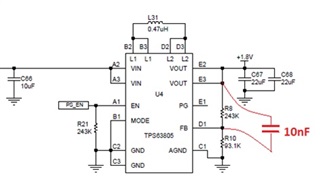We have designed TI’s TPS63805 “Buck/Boost” Switchmode Power Supply IC into one of our battery-powered (uses 2 AAA alkaline batteries) headsets.
The issue we are having is that in low power conditions (approximately 10mA) we are getting a high-pitch audible tone in our earpiece. It appears that the TPS63805 switching frequency is the root cause of this tone.
We did not foresee this condition when we first designed the product, but as a corrective action we are looking for ways to shift the switching rate to a higher frequency that is above the audible range (20Khz or higher).
One obvious way to try to shift the frequency up is to increase the load, but our headset is battery powered and doubling the current would result in a drastic degradation on the usable life of the battery/product.
We have started to experiment with ways to alter the feedback loop to “trick” the IC into switching at a faster rate. One way we found to do this is to introduce a parallel capacitor on one of the resistors in the resistor-divider feedback loop. Our concern with doing this is whether the TPS63805 will remain stable under all operating conditions with the introduction of this capacitor. We are looking for TI’s help to understand the impact of this addition capacitor – for example there may be a range of acceptable capacitor values that we may need to stay within.
In the end, our goal is to shift the frequency above the audible range without loss of battery life. Can TI provide advice? Perhaps there are other ways to accomplish this goal?
Below is an excerpt of our schematic showing the circuitry surrounding the TPS63805.
We are experimenting by putting a parallel capacitor (10nF) across R8 (as shown in the schematic excerpt below). What we don’t know is whether we are unintentionally violating the performance/stability of the switcher by making this addition/change.


